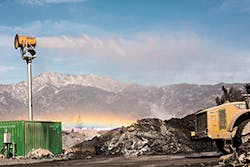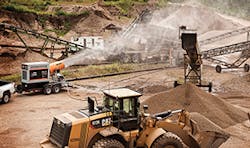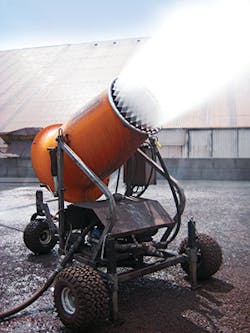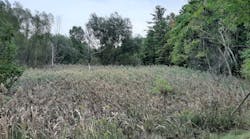Improved Technology for Controlling “Fugitive Dust”
Editor’s note: This article first appeared in the March 2016 edition of Erosion Control.
Dust—it’s everywhere, and seems to accumulate literally from thin air. It seems harmless but it is anything but that. Dramatic photos that captured the devastation of the central plains Dust Bowl of the Great Depression are compelling evidence of how dry, vulnerable soil, transported by wind, transforms the landscape.
While we have learned much about controlling dust since then, dust is still with us every day. Whether it’s on your furniture, billowing from a construction or industrial site, or making your drive home on a country road hazardous, dust is a pervasive and unwanted fact of life.
But industrial dust is far more troublesome than the stuff on the dining room table. As these particles settle on waterways and vegetation they can harm the environment, and when inhaled by wildlife, livestock, and humans can cause respiratory distress. Numerous chemicals and hazardous materials that become airborne as a byproduct of commercial operations are also downright deadly.
The effect of dust from industry or commercial operations is further intensified by the conveyances taking their commodities to and from railheads or other destinations. The result is that over time, dust takes its toll as road surfaces literally blow away, contributing to erosion and frequent, costly surface repairs.
For decades, mitigating this nonpoint-source dust—”fugitive dust”—has been a daily nuisance. On mining, construction, demolition, and agricultural sites, at scrapyards, and on countless miles of unpaved roads across the country mitigation was routinely performed with water sprayers and hoses, often with added chemicals that in themselves were environmentally undesirable. “Keeping the dust down” was an inexact science. But with the passing of the 1970 Clean Air Act and 1972 Clean Water Act (CWA), fugitive dust was subject to increased regulation. Technology rallied to develop better methods and innovative products that today are key to controlling dust.
Engineering Dust Control
“The year 1975 was in a way the birth of the modern dust control industry,” says Bob Vitale, founder and CEO of Midwest Industrial Supply Inc. in Canton, OH. With the advent of the CWA, “A need arose for products to control dust that were non-dangerous to use, and non-harmful to human health.” But controlling dust requires a complex analysis of each situation, explains Vitale.
“For example, when you are a evaluating a situation such as dust coming off a road, you need to know several factors. How many miles are affected, how well is the road constructed, what are the materials the road is made out of? Then you need to know details of the road traffic. How many vehicles travel each day? How fast are they going? And how much do they typically weigh? These are a few of a number of data points that must be defined to know how the level of dust is generated and then to very deliberately define the type of dust control you want.”
Vitale’s company manufactures a number of products for dust control, such as Soil Sement, EnviroKleen, and EK35, each “with a different chemistry to fit a specific capability.”
“The polymer emulsion and binders of these products have tremendous engineering properties, and are within the field of nanotechnology,” he says. Vitale explains that the products are designed to “coat and bind all of the small particles and hold them together.” In effect this allows the treated surface to withstand wear, and as the products are water and sun resistant, the surfaces are very resilient to climate and weather.
“Our whole approach to solving dust and erosion is to keep the road where it belongs. All of our solutions are designed to work with the customer to find what process will work best to keep it that way.”
From roadways to runways, more than 35 specialized products provide users customized dust control. And controlling dust, in some instances, can literally save lives.
Keeping the Surface Grounded
While the term “staying connected” implies having a strong Internet connection, for some it is more literal. In Alaska and Canada, the climate poses challenges to transportation, and many remote areas depend on air transport using gravel runways for everyday necessities. However, the severe climate and low daylight levels for many months make it challenging to maintain the surface of these gravel runways. Between freeze/thaw conditions and the stress of landing and takeoff of heavy aircraft, frequent breakdown of gravel runway surface is unavoidable. But loose gravel is a hazard, as it can damage aircraft, cause a breakdown of the aggregate, and create dust that impairs visibility for pilots and settles on nearby villages. Drainage problems and subsequent erosion also create a safety hazard to aircraft and surrounding communities.
To preserve these runways, Midwest implemented its Runway Fines Preservation process using EK35 and EnviroKleen. With this process, the runways are first prepared by grading, followed by multiple applications of EK35 and/or EnviroKleen, using a serial sprayer available from Midwest that binds and stabilizes the surface.
“Not only does this reduce gravel runway maintenance costs by 50%, but the surfaces take on a pavement-like strength, and dust is reduced by 80 to 95% for up to four years,” says Vitale. He notes that pilots and runway operators in these remote regions have been satisfied with the results. “There is minimal damage to aircraft from foreign object debris, and since there is practically no dust, this means increased passenger and aircraft safety as well.”
However, prior to the application, says Vitale, an analysis of the surface aggregate is needed, as well as consideration of climate conditions, traffic, and more to create the most appropriate solution and treatment plan.
“All of our family of synthetic fluid products are environmentally sound and safe for humans. It is extremely pure and nontoxic to the environment, as our binders include pitch resin, which is naturally occurring from trees.”
When treated, the runway has an improved surface strength and is virtually maintenance free, and dust is controlled to minimal levels.
According to the Alaska University Transportation Center, Midwest’s EK35 was selected for inclusion in studies to investigate longevity of dust control palliatives because of rural Alaska’s need to find cost-effective methods to reduce road and airfield dust.
The trailer-mounted fusion unit has its own power generator.
Being a Good Neighbor
Holland, MI, located on the eastern shore of Lake Michigan and with a current population of more 33,000, was a very different town in 1905, when Louis Padnos founded his scrapyard there. Today, more than a century later, the Padnos scrap and recycling operation is still in the same place but has grown to serve many locations across Michigan.
“The town of Holland literally grew up around us,” says company spokesperson Tim Driesenga.”Over the years the company invested in large scrap processing equipment, and it’s not something you can just up and move. However, we are sensitive to our neighbors, and we’ve made it our responsibility to manage and control the dust that is created from our operation.”
Driesenga says that the company’s Holland location, while not the biggest in volume, at 29 acres is the largest in size. Dust is generated both from the processing of scrap and from the trucks that transport the final product to steel mills and foundries. Driesenga explains how dust occurs in this industry that handles mostly metals, a product not usually thought of as dust producing.
DustBoss unit
“We have a lot of loose sheet iron from auto bodies and old appliances—washers, dryers, and so forth—all post-consumer scrap. The advantage to our processing is this all has value and it can be recycled, but the intrinsic value is landfill avoidance.”
But dust is a problem. “Scrap itself is dirty; it’s oxidized or rusty. But in the high traffic areas where we’re moving all that, we’ve solved the problem with the DustBoss from Dust Control Technology [DCT],” says Driesenga.
“People’s expectations have changed from what they were willing to accept 20 or 30 years ago, and the company has committed to being a good neighbor in the community. The town grew up around us, and we have to make sure we hold ourselves to high standards in dust control.”
DCT president Laura Stiverson explains the dust control capabilities of the line of DustBoss products. “This unit is designed to mitigate fugitive dust using an atomized mist with a water droplet comparable in size to the dust particles, so they are ‘attracted’ to each other, which then makes the particle heavy so it falls to the ground.
“The key component is a ducted fan that is engineered to create a column of air mixed with water in a fine mist. They have a lot of coverage; the largest one can shoot mist out 300 feet. The fine mist is generated by multiple nozzles. Some units have up to 30 nozzles, but we help customers determine which machine, how many nozzles, and how much mist they will need to generate to match the amount of dust they have.”
The DustBoss looks something like a large portable cement mixer and can be mounted on a truck and moved to different locations. Some can be mounted high up on pedestals with their rotation governed by a remote-control operator, who can direct the mist to where it needs to be.
“We also have a Fusion unit paired with a generator and placed on a trailer, so the power is right there,” says Stiverson.
After 10 years, the first DustBoss machines are still going strong, and Stiverson says they are now used in more than 35 countries. “Customers who have been using conventional water spraying to control dust will see significant benefits in lowered operational costs plus substantial savings in water use when switching to DustBoss. We make every effort to listen to the customer and meet their needs, and sometimes that means reinventing our own product.”
Back to the Drawing Board
This flexibility was key for the Padnos operation. Driesenga describes how the scrapyard purchased its first DustBoss, then increased the number of units. But when they asked for custom remote capabilities, “We really stretched the DustBoss people,” he says.




